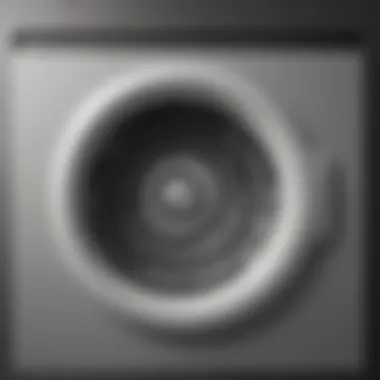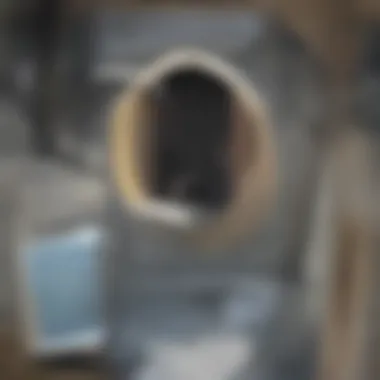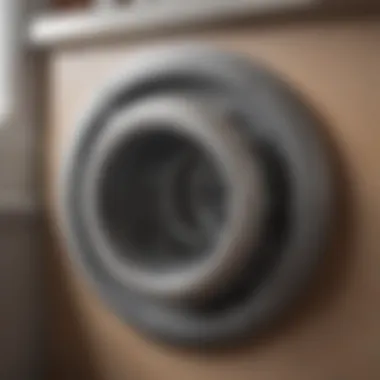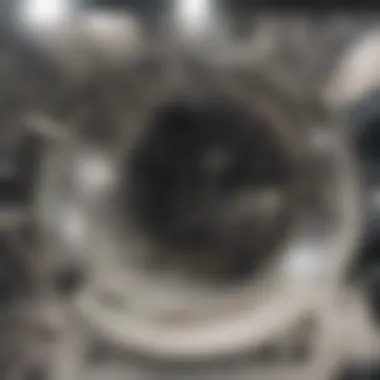Understanding Clogged Exhaust Vents in Dryers


Intro
Clogged exhaust vents in dryers are a common yet often overlooked problem. Understanding why this occurs, its implications, and how to prevent it is essential for maintaining safety and efficiency in the home. Homeowners tend to neglect the external vent system, focusing instead on the interior features of their dryers. However, neglecting the vent can lead to serious consequences. This article aims to address the causes of clogged exhaust vents, the potential risks associated with them, and the practical solutions available.
Importance of Proper Ventilation
Maintaining proper dryer ventilation is critical for several reasons. A well-functioning exhaust vent helps in efficiently removing hot air and moisture. This reduces drying time and improves energy efficiency. Moreover, proper ventilation minimizes fire risks and enhances the lifespan of the appliance.
Common Causes of Clogs
Clogs in dryer vents can result from various factors, which are essential to recognize:
- Lint Buildup: Lint is one of the primary culprits for clogs. Over time, lint accumulates in the venting system, obstructing airflow.
- Obstructions Outside: Leaves, debris, or nests can block the exterior vent, decreasing the effectiveness of the exhaust system.
- Improper Installation: Incorrectly installed ductwork might create unnecessary bends or kinks, making it easier for lint to accumulate.
- Wear and Tear: Deterioration of the vent material over time can lead to gaps that trap lint.
Consequences of Clogged Vents
Failing to address clogged vents can lead to serious issues such as:
- Fire Hazards: Lint is highly flammable. Accumulated lint in vents increases the risk of dryer fires.
- Increased Energy Costs: A clogged vent forces the dryer to work harder, consuming more energy.
- Extended Drying Times: Clogs prevent optimal airflow, leading to longer drying cycles and user frustration.
"Regular maintenance of dryer vents is not just advisable; it is crucial for home safety and operational efficiency."
Solutions for Clogged Vents
Addressing the problem of clogged exhaust vents involves several steps:
- Regular Inspections: Homeowners should inspect their dryer vents for lint buildup at least once a year.
- Cleaning: A thorough cleaning can be done with a vacuum or specialized cleaning kits designed for dryer vents.
- Professional Help: If clogs are severe, it might be necessary to enlist the help of professionals who specialize in vent cleaning.
- Upgrade Duct Material: Consider replacing flexible ducting with rigid metal ducts that minimize lint accumulation.
- Use a Lint Trap: Installing a lint trap can catch excess lint before it reaches the vent.
Foreword to Dryer Vent Systems
Dryers are essential appliances in many homes, facilitating the quick drying of clothes. However, a crucial component of their operation often goes unnoticed until problems arise: the dryer vent system. Understanding this system is not only beneficial for the efficient functioning of the dryer but is also vital for safety.
Purpose of the Exhaust Vent
The primary role of the exhaust vent in a dryer is to expel hot, moist air generated during the drying process outside the home. This function prevents the buildup of humidity within the laundry area, which could lead to the growth of mold and mildew. Moreover, the vent also carries lint and other particles away from the dryer, which is essential for minimizing the risk of fire hazards.
In addition to these benefits, a properly functioning exhaust vent significantly enhances dryer efficiency. When air flows correctly through the vent, the dryer doesn’t have to work as hard to dry clothes, reducing energy consumption. This reduction can lead to lower energy bills over time, which is an important consideration for homeowners managing utility costs.
Components of a Dryer Vent System
A dryer vent system consists of several critical components that work together to ensure safe and effective operation. These components include:
- Dryer: The appliance itself, which generates heat and moisture.
- Transition Duct: A short, flexible duct that connects the dryer to the vent exhaust system.
- Vent Duct: This is typically a rigid metal duct that carries air from the dryer to the outside of the house. It can be straight or have bends depending on the layout.
- Wall Cap: The exterior outlet of the vent system that allows expelled air to exit. It often contains a flap or grille to prevent back-draft and deter pests.
Ensuring that each of these components is functioning and securely attached is vital for maintaining airflow. Inadequate or damaged components can contribute to restricted airflow, leading to clogs and serious consequences, including potential safety hazards and appliance inefficiencies.
The dryer vent system is a vital, yet often overlooked aspect of regular dryer maintenance. Understanding its purpose and components can help avoid costly repairs and safety hazards.
Understanding Clogs in Exhaust Vents
Clogs in dryer exhaust vents can lead to significant problems for homeowners, from safety hazards to increased energy costs. Recognizing and understanding these issues is crucial for maintaining efficient dryer operation. This section aims to shed light on the common causes of clogged vents and the warning signs that homeowners should look for.


Common Causes of Clogs
Clogs in exhaust vents typically stem from several prevalent factors. Identifying these causes is the first step towards effective prevention.
Lint Accumulation
Lint accumulation is a primary factor that leads to clogs in dryer vents. Lint is the fine fabric particles that detach from clothes during the drying process. Over time, this material can build up within the vent, resulting in blockages. The key characteristic of lint is its ability to trap moisture and restrict airflow. This buildup often occurs in areas with limited access or poor ventilation.
One significant advantage of addressing lint accumulation promptly is the prevention of potential dryer fires. As lint gathers, it becomes more flammable, especially when exposed to high heat. Regular cleaning and maintenance routines can minimize this risk and enhance the dryer’s efficiency.
Obstruction from Debris
Obstruction from debris is another factor contributing to clogged dryer vents. Debris can come from various sources, including outdoor elements like leaves, bird nests, or even dirt that enters the vent from the exterior side. A common characteristic of debris is its unpredictability; homeowners may not notice it until significant blockage occurs. This can lead to poor drying performance.
The unique challenge with debris is that it can create varying levels of blockage, which might lead to inconsistent dryer operation. Homeowners need to ensure their vents are protected from external elements and inspect them periodically to avoid this problem.
Constricted Ventilation Pathways
Constricted ventilation pathways can severely limit airflow, causing clogs in dryer vents. Such constrictions may arise from improper installations or bends in the venting system. The key feature here is the design of the vent, which must facilitate unobstructed airflow outward.
One disadvantage of constricted pathways is the strain they put on the dryer’s motor, potentially leading to higher energy consumption and a shorter lifespan for the appliance. It’s crucial for homeowners to evaluate their vent installation and ensure it follows the manufacturer's guidelines to prevent these issues.
Signs of a Clogged Exhaust Vent
Recognizing the signs of clogged exhaust vents is equally important. These indicators can help homeowners act before significant damage occurs.
Longer Drying Times
Longer drying times is a noticeable sign that indicates possible clogs in the exhaust vent. If clothes are consistently coming out damp after the cycle, there may be an obstruction. One characteristic of longer drying times is the increasing frustration for users, leading to more frequent drying cycles.
This issue not only wastes energy but also places extra wear on the dryer. Homeowners should monitor their drying times and take note of any prolonged cycles as a prompt to check for clogs.
Burning Smell from Dryer
A burning smell from the dryer is a serious warning sign that should not be ignored. When the vent is clogged, excessive heat can build up, causing lint and other materials to overheat. This characteristic is alarming and can indicate a fire risk.
Homeowners should take immediate action if they detect this smell, as it can signify a dangerous situation within the dryer system.
Excessive Heat Buildup
Excessive heat buildup in the dryer cabinet is another clear indicator of potential vent clogs. When airflow is restricted, heat cannot escape, causing the internal components to overheat. A key feature of excessive heat is its negative impact on the efficiency of the dryer and its components.
This situation can ultimately lead to breakdowns, resulting in costly repairs. Homeowners should regularly touch the dryer surface during operation to ensure it does not feel excessively hot, as this can signal vent blockage.
In summary, understanding the common causes and warning signs of clogged exhaust vents is crucial for effective dryer maintenance. Regular inspections and timely action can help prevent significant issues down the line.
Consequences of a Clogged Dryer Vent
Understanding the consequences of a clogged dryer vent is essential for any homeowner. When exhaust vents become obstructed, it can lead to serious safety issues, increased energy consumption, and diminished appliance functionality. Identifying these consequences allows homeowners to take proactive measures to maintain their equipment and ensure a safe environment at home.
Fire Hazards


One of the most alarming risks associated with clogged dryer vents is the potential for fire hazards. Lint buildup is a highly flammable material, and when it accumulates in the vent system, it can ignite due to the high temperatures generated by the dryer. Statistics show that failure to clean dryer vents is a leading cause of home fires. According to the U.S. Fire Administration, thousands of structured fires occur annually due to dryer-related issues. Homeowners must be vigilant; regularly checking and cleaning their dryer vent can significantly reduce this risk.
Inefficiency and Increased Energy Costs
A clogged dryer vent leads to inefficiency in the dryer’s operation. When airflow is restricted, the dryer must work harder to dry clothes effectively. This extra effort results in prolonged drying times and increased energy consumption, causing utility bills to rise. Over time, the strain placed on the appliance can also lead to a shorter lifespan of the dryer. On average, homeowners can save on energy costs by ensuring their dryer vents are free from clogs. Regular maintenance checks can provide not only financial benefits but also enhance environmental responsibility by reducing energy waste.
Impact on Dryer Performance
The impact on dryer performance due to clogged vents should not be underestimated. A restricted vent system disrupts the dryer’s ability to expel moisture, leading to damp clothes upon completion of a drying cycle. This inefficiency may prompt homeowners to run extra cycles, wasting time and resources. Furthermore, improper venting can cause overheating of the dryer’s components, leading to wear and potentially necessitating costly repairs. Being aware of these performance issues is critical. Regular inspection and cleaning of dryer vents can help maintain optimal performance and extend the lifespan of the appliance.
In summary, the consequences of a clogged dryer vent extend far beyond mere inconvenience. Understanding the risks, inefficiencies, and performance issues can empower homeowners to take the necessary steps for preventive care, ensuring safety and efficiency in their laundry routines.
Preventing Clogs in Dryer Vents
Preventing clogs in dryer vents is crucial not just for the efficiency of the appliance but also for safety concerns. Clogged vents can lead to overheating, potential fires, and increased energy costs. The significance of this preventive measure should not be overlooked by homeowners. Implementing systematic strategies to manage vent maintenance can save time, money, and increase the lifespan of the dryer.
Regular Maintenance Routines
Establishing regular maintenance is one of the most effective ways to prevent clogs. This involves a schedule for cleaning lint traps and vent ducts.
- Cleaning Lint Filters: Each time you do laundry, you should clean the lint filter. This quick task only takes a few seconds but significantly reduces lint buildup.
- Professional Inspections: Having a professional check the entire vent system once a year is advisable. They can detect problems that may not be visible.
- Personal Cleanings: Homeowners can invest in specific cleaning tools, like lint brushes or specialized vacuum attachments, to clean ducts where clogs may build up.
By incorporating these steps into typical routines, the risk of clogs diminishes dramatically, promoting a safer laundry environment.
Optimal Ventilation Practices
Optimizing ventilation practices is also essential. Proper airflow helps in reducing the possibility of lint accumulation.
- Avoid Sharp Bends: The vent should have as few bends as possible. Sharp bends obstruct airflow, leading to increased lint settling in these areas.
- Shorter Vents: Install the vent as straight and short as the design allows. This allows air to flow smoothly out of the dryer.
- Use the Right Diameter: Always ensure that the duct has the appropriate diameter for your dryer model. Too small a diameter restricts airflow.
Proper ventilation not only improves dryer efficiency but also minimizes the hazards associated with overheating and fires.
Choosing Proper Vent Materials
The choice of vent materials plays a significant role in preventing clogs. Selecting the appropriate type of venting material can lead to long-term performance benefits.
- Metal Vents: Opt for rigid or semi-rigid metal ducts rather than plastic. Metal is less likely to collect lint and holds up better to heat.
- Smooth Interior Surfaces: Look for ducts with smooth interiors. These surfaces promote better airflow and do not trap as much lint compared to ribbed surfaces.
- Approved Materials: Ensure the vent material is compliant with local building codes. This compliance guarantees that the material is appropriate and safe for installation in homes.
Steps for Cleaning a Clogged Dryer Vent
Cleaning a clogged dryer vent is crucial for maintaining the efficiency and safety of the appliance. Vent blockages can lead to overheating and potential fire hazards, making this maintenance step non-negotiable. By removing lint and debris, homeowners can also enhance drying times and extend the life of their dryers. In this section, we will discuss the specific steps essential for effective cleaning.
Gathering Necessary Tools
Before beginning the cleaning process, gather the appropriate tools. This preparation ensures the task can be carried out efficiently without interruptions. Key items that are typically needed include:
- A lint brush, ideally with a long handle.
- A vacuum cleaner with a hose attachment for better reach.
- Screwdrivers for disassembling the vent parts easily.
- A flashlight to inspect dark crevices.
- A pair of gloves for protection during the cleaning.
Having these tools at hand will expedite the cleaning process and allow for thorough maintenance.
Disassembling the Vent System


The next step involves disassembling the vent system. This process is important to access all areas where lint may accumulate. Start by unplugging the dryer and disconnecting the duct from the back. Carefully remove screws or clamps holding the vent in place. Maintain a systematic approach to ensure you remember how to reassemble the parts later. Proper disassembly will allow for a comprehensive clean and prevent any accidental damage.
Cleaning Techniques
When it comes to cleaning the vent, employ effective techniques to ensure thorough lint removal. Three primary methods include using a lint brush, vacuuming the vent, and inspecting for any damage.
Using a Lint Brush
Using a lint brush is a popular method for cleaning dryer vents. The long handle allows access to deep areas, where lint clogs often form. A lint brush usually consists of soft yet firm bristles, which gently capture lint without damaging the vent walls. One key characteristic of a lint brush is its flexibility; it can navigate bends in the ductwork effectively. However, this method requires some diligence, as brushes may need replacement over time if bristles become worn out.
Vacuuming the Vent
Vacuuming the vent is another efficient cleaning technique. A vacuum cleaner's suction power can remove substantial amounts of lint quickly. Most homeowners already possess a vacuum, making this choice practical. Its unique feature lies in its ability to reach small particles that may evade a lint brush. However, it is critical to use the appropriate attachments; standard hoses may not fit in all vent systems.
Inspecting for Damage
After cleaning, inadequately overlooked areas could still harbor issues. Inspecting for damage is essential to ensure the vent system's integrity. Look for any cracks or obstructions in the duct. A thorough inspection can reveal deteriorated sections that may require immediate replacement. This step not only secures safety but also improves overall dryer efficiency. Monitoring these aspects ensures the system operates optimally over time.
Reassembly and Testing
The final step involves reassembling the vent system after cleaning. Replace all duct components as per the order they were removed. Once secured, plug the dryer back in and run it for a short cycle to check for proper airflow. Listen for any unusual noises that may indicate improper installation. Verifying the system functions correctly ensures the effectiveness of the cleaning efforts.
When to Call a Professional
Dealing with clogged dryer vents can often be a straightforward task for most homeowners. However, there are moments when the situation exceeds one's skill set or the available tools. Recognizing when to call a professional is essential for ensuring the safety and efficiency of your drying system.
Indicators of Severe Clogs
Several signs indicate the need for professional intervention. These indicators can help homeowners to avoid the potential dangers associated with severe clogs. Common warning signs include:
- Incessant Drying Cycles: If the dryer requires multiple cycles to dry a single load, this could indicate an obstruction within the vent.
- Presence of Lint or Debris Outside: Observing lint or debris at the vent exit is a clear signal of a blockage.
- Burning Odor: Smelling burning odors from the dryer can be a serious warning, often a product of overheating due to restricted airflow.
- Heat Accumulation: Excessive heat on the dryer’s exterior can lead to safety hazards and typically means airflow is inadequate.
These signs indicate that the situation is not just inconvenient but could evolve into a safety concern.
Benefits of Professional Cleaning Services
Hiring professional cleaning services for your dryer vent has numerous advantages. While a do-it-yourself approach might be tempting, the expertise of trained technicians can ensure thorough cleaning and safety. Key benefits include:
- Comprehensive Inspection: Professionals can perform a complete evaluation of the ventilation system, detecting issues missed during a standard cleaning.
- Advanced Tools and Techniques: With access to specialized tools, professionals can tackle challenging clogs that standard tools cannot handle effectively.
- Time-Saving: Cleaning a dryer vent thoroughly can be time-consuming. Professionals can often do this quickly and efficiently, allowing you to focus on your daily activities.
- Enhanced Safety: With expert knowledge, they handle the risks associated with electric or gas connections safely, reducing the danger posed by improper handling.
Using these services can ultimately prolong the lifespan of the dryer. It also helps to reduce energy costs by ensuring the system performs at its best.
It is crucial to recognize when the severity of the situation surpasses the capabilities of DIY methods. Professional help is not just an option; sometimes it is a necessity.
Closure
In this article, we have examined the significant issue of clogged exhaust vents in dryers. This problem not only affects the efficiency of your appliance but also poses serious safety risks. Understanding the causes, consequences, and solutions is essential for homeowners who wish to maintain their dryers effectively and avoid potential hazards.
Summarizing Key Points
- Causes of Clogs: Key reasons for clogs include lint accumulation, debris obstruction, and restricted pathways. These elements make it crucial to be vigilant in maintaining the dryer vent system.
- Consequences: A clogged exhaust vent can lead to increased fire hazards, inefficiency that hikes energy costs, and a significant decline in dryer performance. Regular checks can mitigate these risks.
- Prevention and Cleaning: Implementation of proper maintenance routines, utilizing suitable ventilation materials, and following cleaning steps are important practices. These steps ensure continued safe operation.
- When to Seek Help: Recognizing when clogs become severe is vital. Professional cleaning services bring expertise and equipment to solve issues that at-home maintenance might miss.
By understanding these core components, homeowners can ensure their dryers function optimally while reducing risks associated with clogged exhaust vents. The investment of time into regular maintenance ultimately pays off in the longevity and safety of home appliances.
Encouraging Vigilance in Maintenance
It is imperative that homeowners take an active role in the maintenance of their dryer ventilation systems.
- Schedule Routine Inspections: Regular inspections help identify potential issues before they escalate.
- Understand the Signs: Be aware of the signs indicating clogs, such as inefficient drying or unusual smells. Early detection can prevent larger problems.
- Educate & Act: Familiarize yourself with best practices for vent cleaning. This knowledge empowers you to take action proactively.



